

Review Article - International Research Journal of Plant Science ( 2020) Volume 11, Issue 1
Received: 18-Apr-2020 Published: 15-Jun-2020, DOI: 10.14303/irjps.2020.002
Over the past three decades, Gastric cancer risk and prevalence increased causing significant loss to human health worldwide. Mostly resistance developed highly to Surgery and chemotherapy against gastric cancer. Therefore, a need to the development of novel, low cost and efficient treatment methods. Phytoconstituents isolated from fruits are biologically active which attract the attention of pharmaceutical industries and researchers around the world. Pharmacological effects of bioactive compounds to fight against gastric cancer was proved by in vitro and in vivo studies Phytochemicals also regulate several molecular processes like cell cycle arrest, angiogenesis, apoptosis, autophagy, cell invasion and metastasis to combat gastric cancer. This review gives perspectives on key bioactive molecules bioaccessibility, availability and cellular mechanism of action in the gastric cancer. As well as, guide the public in developing functional food and drugs from phytochemicals for the prevention and treatment of gastric
cancer.
phytochemical; gastric cancer; molecular mechanism; apoptosis; anti-cancerous effects
GI gastrointestinal; GC Gastric cancer; APC adenomatous polyposis coli; SMAD small mothers against decapentaplegic; IL interleukins; SCFA short chain fatty acid; Wnt wingless-related integration site; TNF tumor necrosis factor; AMPK adenosine monophosphate activated protein kinase; PI3K Phosphoinositide 3-kinases; STZ streptozotocin; NF-κB nuclear Factor kappa-light-chainenhancer of activated B cells; Bcl-2 B-cell lymphoma 2; NO nitric oxide; SULT sulfotransferases; ACF aberrant crypt foci; UGT UDP-glucuronosyltransferase; GPx glutathione peroxidase; GST glutathione S-transferase; GR glutathione reductase; BAX Bcl-2-associated X protein; JNK c-Jun N-terminal kinases; GSH reduced glutathione; COX-2 cyclooxygenase 2; Nrf2 nuclear factor erythroid 2-related factor 2; PACs predominant A- type procyanidins; EGFR epithelial growth factor receptor; TBARS thiobarbituric acid reactive substances; ROS reactive oxygen species; SAMC S-allylmercaptocysteine; ACSOs alk(en)yl cysteine sulphoxides; MseC Se-methyl-L-selenocysteine; MDSCs myeloid-derived suppressor cells; MMP matrix metallopeptidase; ICAM intercellular adhesion molecules
The estimates of cancer cases for Indian males are 462,408; 497,081 and 534,353 and females are 517,378; 563,808 and 614,404 for the years 2010, 2015 and 2020, respectively. Further, the total cancer cases grown up to 1,148,757 cases in the year 2020. The major first three contributors for the year 2020 will be stomach (45,196; 19.8%), esophagus (42,513; 18.6%) and colon (32,433; 14.2%) Ramnath Takiar et al., (2010) Gastric cancer (GC) or stomach cancer, is a cancer that begins in the mucus-producing cells on the inside lining regions of the stomach. In India, based on various registries, there is a drastic change in the epidemiology of gastric cancer.
Compared to western countries, the prevalence rate of gastric is very low and with a male predominance (maleto- female ratio, 2:1), the new gastric cancer cases are approximately 34,000. Estimated that in year 2020, approximately 50,000 new gastric cancer cases will be reported annually. Recent cancer mortality survey in India indicated that gastric cancer remains the fifth most common cancer among males and seventh most common cancer among females Dikshit R. (2012) Only 27% patients undergoing surgical resection survived for 5-year was reported. The prevalence rate of gastric cancer is four times higher in Southern India compared with Northern India GLOBOCAN 2018 data revealed that stomach cancer is the 5th most common neoplasm and the 3rd most deadly disease, with death rate of 783,000 in 2018. Incidence and mortality are highly variable by region and on diet and Helicobacter pylori infection Van Cutsem. Et al., (2016) In worldwide incidence of gastric cancer, India falls under the low incidence region category Table 1 & Figure 1.
Molecular classification and pathogenicity:
The molecular classification and pathology of gastric carcinoma is depicted in Table 2 & Figure 3 respectively.
| S. No | Cancer site | Males | Females | Combined | ||||||
| 2010 | 2015 | 2020 | 2010 | 2015 | 2020 | 2010 | 2015 | 2020 | ||
| 1 | Oesophagus | 23,280 | 22,114 | 20,642 | 18,417 | 20,070 | 21,871 | 41,697 | 42,184 | 42,513 |
| 2 | Stomach | 25,831 | 27,767 | 29,850 | 12,923 | 14,082 | 15,346 | 38,754 | 41,850 | 45,196 |
| 3 | Small Intestine | 1,355 | 1,457 | 1,566 | 864 | 942 | 1,026 | 2,220 | 2,399 | 2,593 |
| 4 | Colon | 11,613 | 12,483 | 13,420 | 11,895 | 15,205 | 19,013 | 23,509 | 27,689 | 32,433 |
| 5 | Rectum | 12,131 | 13,041 | 14,019 | 9,341 | 10,179 | 11,093 | 21,473 | 23,221 | 25,112 |
| 6 | Anus and Anal Canal | 2,303 | 2,476 | 2,661 | 1,197 | 1,304 | 1,421 | 3,500 | 3,780 | 4,083 |
| 7 | Liver | 14,533 | 15,623 | 16,794 | 8,334 | 10,411 | 12,794 | 22,867 | 26,034 | 29,589 |
| 8 | Gall Bladder. Etc. | 8,677 | 9,328 | 10,028 | 18,504 | 20,165 | 21,975 | 27,182 | 29,494 | 32,003 |
| 9 | Pancreas | 7,304 | 7,851 | 8,440 | 5,128 | 5,588 | 6,090 | 12,432 | 13,440 | 14,530 |
| 10 | Digestive System Cancers | 107,030 | 112,144 | 117,423 | 86,606 | 97,950 | 110,633 | 193,637 | 210,095 | 228,056 |
| S. No | LOCUS | HISTOLOGY | MOLECULAR CLASSIFICATION | |
| Lauren’s classification | The cancer genome atlas (TCGA) research network | Asian cancer research group (ACRG) | ||
| 1 | Gastric adenocarcinomas | Intestinal type | Positive for Epstein-Barr virus (EBV 9%) | Microsatellite instability (MSI) |
| 2 | Gastro-oesophageal-junction adenocarcinomas | Diffuse type | Microsatellite unstable tumours (22%) | Microsatellite stable with epithelial-to-mesenchymal transition features (MSS/EMT) |
| 3 | - | - | Genomically stable tumours (20%) | MSS/TP53 mutant (MSS/TP53+) |
| 4 | - | - | Chromosomally unstable tumours (50%) | MSS/TP53 wild type (MSS/TP53–) |
| Ref | Colquhoun A. et al., (2012) | Cancer Genome Atlas Research Network (2014) | Cancer Genome Atlas Research Network (2014) | Cristescu R. et al., (2014) |
Risk factors
The etiology and symptoms are multifactorial, represented in Figure 2 and 3 respectively Marcus Fernando et al., (2018); 10. Vectorstock (2020). It may differ for proximal and distal gastric cancers. Peoples are diagnosed with gastric cancer between their late 60s and 80s with sharp increase after the age of 50 years Ferlay J. et al., (2010) When symptoms do occur, they may be vague.
Stomach cancer is a vigorous disease has no symptoms and whose projection is still very poor that waive early diagnosis of this disease is difficult Catalano V. et. Al., Although, many of the various treatments developed was failed to cure progression and metastatic condition of GC patients Gallo A. (2006) Thus, an emergency to explore new diagnostic markers and cell and molecular mechanisms involved in the progression of GC.
Herbomics
For all ailments of mankind, the nature, god’s gift is the greatest combinatorial chemistry to give possible solutions. Since the emergence of humankind, from the traditional period herbs, shrubs and plants used as medicine and strong evidence reveals that two-thirds of the plants recommended for therapeutic values. Enormous plant species are markers of compounds that are aid to treat and avert numerous human conditions throughout the world. Based on World Health Organization (WHO) report, ~80% population of world depends herbal medicine for it outlives. Across different cultures and ethnic civilizations medicinal product development from traditional plants sources are encouraged and accepted, since it is estimated that only 10% have been explored among thousands of plant species exist in the world, to prove their pharmacological potential. Studies demonstrating that plants derived bioactive compounds are generally effective in nature with low cost, safe and high-quality as compared to synthetics. “Herbomics” field of art is at the early stage of its occurrence may aid us in articulate individually tailored herbal remedies in this era of precision and personalized medicine Sharma P. et al., (2020)
The objective of review is to give an outline about role of molecular mechanism in healing and curing importance of bioactive compounds isolated from plants with medicinal value in treating stomach or gastric cancer.
Cellular mechanisms of Selected Gastrointestinal Cancer
Generally, mutations affect cellular mechanisms and molecular pathways thereby cause clinical disorders in human system (Figure 4). A mediator in tissue repair and homeostasis is maintained by signaling pathway called wingless-related integration site (Wnt) transduction Komiya Y and Habas R. (2008) In GI cancer patients, increasing the phosphorylation of β-catenin pathway lowered apoptosis Schato E.M. et al., (2017) During cancer, the reduced expression of detoxification enzymes decreases butyrate expression Ramasamy S. et al., (2006)
Figure 4. Schematic illustration of seven selected mechanisms modulated by GI cancer. The figure is divided into seven columns and three rows. The column headings represent the pathways while the row headings represent target genes/ proteins for each pathway (blue), the overview physiological effect of these genes on pathway dark (yellow) and changes occurring on these pathways modulated by GI cancer Raghad Khalid et al., (2020).
Oxidative stress, mitochondrial dysfunction and chromosomal instability are down regulated due to decrease the activity of apoptotic regulatory genes and caspases thereby apoptotic pathways are enhanced in GI cancer Zhang L. et al., (2013) In counting, tumor progression, lipid synthesis and m-RNA translation are up regulated by the activation of phosphoinositide 3-kinases (PI3K)/AKT/ mTOR intracellular pathway Tapia O. et al., (2014) A several beneficial role of Adenosine monophosphate activated protein kinase (AMPK) are improve barrier function and intestinal absorption, in gut health, decrease intestinal inflammation and conceal colorectal cancer Walker J et al., (2005) Inactivation mark of AMPK pathway decreases at the time of GC which augment tumor advancement and mark down apoptotic pathway stimulation Sun X et al., (2017). Enhanced Oxidative stress, cell cycle amelioration and cellular proliferation occur in reduced condition of mitogen-activated protein kinase (MAPK) and Nuclear factor kappa-light-chain-enhancer of activated B cells NFҡB) pathways in the course of gastrointestinal cancer Sokolova, O. & Naumann (2027); Yang M et al., (2015). More activity of NFҡB in budding GC may raise the projection of the disease Lee B.L et al., (2005) To study the relationship between NFҡB and CRC, out of Ninety-two genes tested, only nine genes and twenty two genes are significantly downregulated and upregulated respectively proposing a hard correlation between NFҡB and colorectal cancer Slattery M.L. et al., (2018) Decrement in VEGF production lowered angiogenesis has been demonstrated that the suppression of the NFҡB pathway Xia Y et al., (2014
Selected anticancer mechanisms of bioactive molecules in gastric cancer
Non –nutritive means bioactive chemical compounds symphonize by medicinal plants in specific cells only but not by the metabolism. It has arisen as modulators of critical cellular signaling pathways and developer of health is described in Figure 5 and Table 3 26. Botterweck A.A.M. (2000); Lan H. (2004); Liu Y.B. (2011); Zhu X.Y. (2013) Wu K. (2005) Compounds of plant origin inhibit the proliferation of human gastric cancer cells and the growth of gastric tumors through arresting cell cycle, induction of apoptosis, autophagy, inhibition of tumor angiogenesis and suppression of cell metastasis.
| Bioactive compound | Structure | Source | Molecular targets and Mechanism of action | Anti-cancer effect | Model used | Reference | |
|---|---|---|---|---|---|---|---|
| In vivo | In vitro | ||||||
| Lycopene | 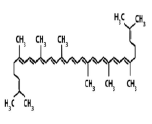 |
Tomato, Guava, Papaya, Grapes and Watermelon | Downregulate AKT/ NF-ҡB /MMP-2,7,9/ TNF /COX-2 Upregulate MAPK/p21 and enzyme such as glutathione reductase, glutathione peroxidises and glutathione S- transferase | Inhibit angiogenesis, cell invasion and metastasis | Sprague-Dawely rats Fischer 344/NISc rats | HT – 29 cell lines | Boehm F. et al., (2016) Lin, M.C. et al., (2011) |
| Quercetin |  |
Cranberry (Vaccinium macrocarpon) | Inhibits the activation of the PI3K/ AKT/ COX-2 signalling pathway and activation of AMPK pathway | Induced cellular apoptosis and reduce cell proliferation | APC (min/+) mice | CCLE, HTT-116 and HT – 29 cell lines | Papps, E., & SchaihK.M. (2006) |
| Ellagic Acid | 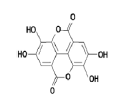 |
Bilberry (Vaccinium myrtillus L) | Inhibit NF-ҡB Reduce expression of pro inflammatory cytokines Suppress the activity of topoisomerase | Induce apoptosis | Balb/c mice | HTT-116 cell line | Hodges, R.E.; Minich, D.M. (2015) Lala, G et al., (2006) |
| Pectolinarigenin |  |
Cirsium chanroenicum | Downregulate p-4EBP1, p-p70S6K, and p-eIF4E, Upregulate LC3-II conversion | Inhibit cell proliferation, induce apoptosis and autophagy | - | AGS and MKN-28 cells | Lee, H.J et al., (2018) |
| Poncirin |  |
Citrus fruits | Upregulate FasL, caspase-8, caspase-3 and PARP cleavage | Inhibit cell proliferation and induce apoptosis | - | AGS cells | Saralamma, V.V. G et al., (2o15) |
| α-Mangostin |  |
Mangosteen | Downregulate STAT3, Bcl-xL and Mcl-1, Upregulate cytochrome c | Induce apoptosis | - | BGC-823 and SGC-7901 cells | Shan, T. et al., (2014) |
| Myricetin |  |
oranges | Expression of apoptosis-related proteins and cyclins and binds to RSK2 increased expression of Mad1 | Inhibits cell proliferation induces apoptosis | - | HGC-27 and SGC7901 cells | Feng, J. etal., (2015) |
| Kaempferol |  |
Grapes | Up-regulating miR-181a and inactivating pAKT/MAPK/ERK and PI3K pathways | Promoted autophagy | - | SNU-216 MKN28 and SGC7901 cell lines | Kim, T.W et al., (2017) |
| Luteolin | 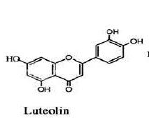 |
Chrysin, Capers, Apples, | Cyt c/caspase pathway activate Notch1 and β-catenin Upregulate epithelial biomarker E-cadherin and downregulating the mesenchymal biomarkers N-cadherin, vimentin and Snail. | Inhibited cell proliferation, invasion, and migration | Male BALB/c nude mice | Hs-746T and MKN28 GC cells SGC-7901 cells | Zang, M.D et al., (2017); Ming-de Zang et al (2017) |
| Apigenin | 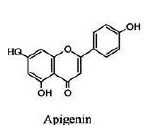 |
Grapefruit, oranges | reduce Bcl-2 levels, enhance Bax level, enhanced intracellular ROS generation and Ca2+ release together with damaged mitochondrial membrane, and upregulated protein expression of CHOP, DR5, cytochrome c, cleave caspase-3, caspase-8 and caspase-9 | Induce apoptosis anti-proliferation, | - | HGC-27 and SGC-7901 HCT-116 cells | Wang, B., & Wang, B. (2017). Kun Wu et al., (2005) |
| Chlorogenic acid | 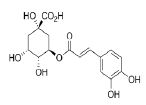 |
Morus macroura (mulberry) | Reactive oxygen species (ROS) production, loss of mitochondrial membrane potential (MMP), m-TOR/PI3K/AKT signalling pathway, | Induce apoptosis, cell migration and invasion suppression | Male BALB/c nude mice | AGS | Wei Fang et al., (2019) |
| Cyanidin-3-O-glucoside (C3G). | 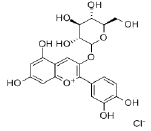 |
Chinese bayberry (Myrica rubra Sieb. & Zucc.) | increased inhibition of matrix metalloproteinase 2 | Inhibition of cell invasion and metastasis | SGC7901 cells AGS, and BGC823 | Chongde Sun Et al., (2012) | |
| Rutin |  |
Apple, Figs, citrus fruits | Death receptor pathway/ p38/Caspase | Inhibited cell proliferation and induced apoptosis | SGC-7901 | Qi Li et al (2019) | |
| β-Carotene, Lutein and lycopene | 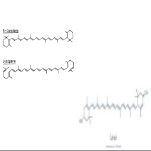 |
Carrots, tomato, orange,pappaya | Inhibit H2O2 induced increase of intracellular ROS levels, activation of NF-κB, and IL-8 expression | Inhibiting cell proliferation and inducing apoptosis | Direct intake by human | AGS cells. | Youngha KIM et al., (1999) |
| Dopamine |  |
Apples, bananas, berries, watermelon, and papaya | Inhibition of DRD2 receptors/EGFR/AKT/MMP-13 pathway | Apoptosis, cell invasion and migration | AGS | Jiasheng Mu et al., (2017) | |
| Alpinumisoflavone |  |
Derris eriocarpa | Suppressing the expression of Nrf2 and Nrf2-driven antioxidant molecule up-regulation of miR-370 and suppression of PIM1 signaling | inhibiting cell proliferation and inducing apoptosis | BALB/c nude mice | EC9706 KYSE30 Het-1A | Han Y Et al., (2016) |
| Derrone |  |
Cudrania tricuspidata | Induction of ROS and ERK | Induces autophagic cell death | - | Hep G2 (HB-8065) A549 cells | Kang M-J et al., (2019) |
| Stigmasterol β- sitosterol | 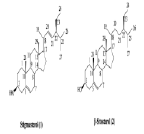 |
Solanum xanthocarpum | The antiproliferative effects were due to induction of mitochondrial-mediated apoptosis by Bax and Bcl-2 expression Inhibit the JAK/STAT signalling pathway | Inhibit Cell migration and proliferation | - | SNU-1, GES-1 | Khana, S etal., (2012); Kang Li etal, (2020) |
It has been well reported that different phytochemicals can inhibit the proliferation of gastric cancer cells in invivo and invitro model. Diallyl disulfide could inhibit cell proliferation by inducing G2/M phase arrest in cell cycle by switch on MAPKinase pathway Yuan J.P. (2004) Apart from this, several in vitro studies proved allitridi Mahady G.B (2002) mycelia and polysaccharides of a mushroom Sun X. & Zhu M.J.(2017) Curcuma mangga rhizomes contains labdane diterpenes Liu Y.B. (2011) poncirin Zhu X.Y. (2013) and apigenin Wu K. (2005) suppress the human gastric cancer generation by various mechanism. Apoptosis play a pivotal role in the prohibition of beginning and progression of cancer. Phytocompound of long pepper, piperlongumine promote mitochondrial dysfunction and hold down the activity of thioredoxin reductase 1 (TrxR1) through reactive oxygen species (ROS)-triggered ER-stress ends in the stimulation of apoptosis Zou P. (2016) Protocatechuic acid cause apoptosis via Fas/FasL death receptor or by mitochondrial pathways associated with phosphorylation of c-Jun N-terminal kinase (JNK), p38 mitogen-activating protein kinases (MAPK), and p53 Lin H.H. (2007) Also, poncirin promote programmed cell death with upregulation of FasL protein through death receptor pathway, stimulating Caspase-8 and Caspase-3, and cleavage of poly (ADP-ribose) polymerase (PARP) Saralamma V.V.G. (2015) Furthermore, due to the decrease of mitochondrial membrane potential by α-mangostin purified from mangosteen promote apoptosis and the inhibition of STAT3 signaling pathway with decreased B-cell lymphoma-extra-large (Bcl-xL) and apoptosis regulator Mcl-1 protein levels Shan T. (2014) Intracellular material renewal and recycles process is called autophagy. Kaempferol, a flavanoid induce autophagic cell death through AMPK/ULK1 and IRE1/ JNK/CHOP pathways Steevens J. (2011) Additionally, anticancer activity promoted by pectolinarigenin inducing autophagy with downregulation of PI3K/Akt pathway or mammalian target of rapamycin (mTOR) pathway Lee H.J. (2018) Anti-angiogenesis activity of zerumbone via the prohibition of NF-ҡB by decreasing the expression of VEGF Tsuboi K. (2014) Tangeretin by decreasing the expression of Notch-1, two serrate-like ligands (Jagged1/2),2 transcription factors (Hey-1,Hes-1) and raise of miR-410 inhibits radiation-mediated EMT and cell invasion and migration Zhang X.K. (2015) Besides, downregulation of PI3K/Akt pathway by gallic acid can inhibit the metastasis Ho H.H. (2010)
Final Thoughts
Together, fruits originated phytochemicals summarized above clearly found as anti-cancer agent by exert genetic alterations in targeting signal transduction pathways. Some common mechanisms of actions of phytochemicals in targeting cancer growth prevention are inhibiting cell proliferation by cell cycle arrest; induce apoptosis, autophagy and cell invasion and metastasis. This was proved in very minimum studies only. so, many studies are need to support the action of phytochemicals in promising means of enhancing cancer prognosis and possibly prevention. Thus, bioactive molecules could potentially help to predict the health status of humans.
Copyright: © 2020 International Research Journals This is an open access article distributed under the terms of the Creative Commons Attribution License, which permits unrestricted use, distribution, and reproduction in any medium, provided the original work is properly cited.